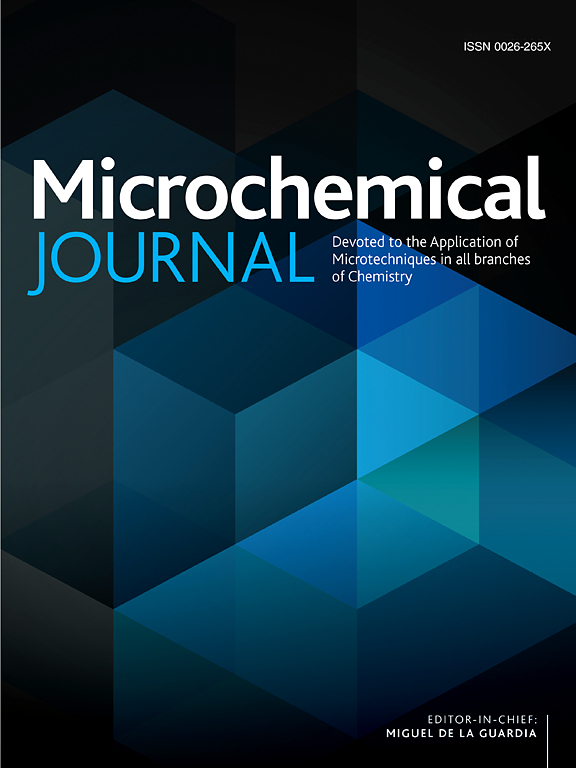na3ca辅助后颈处理Bi4TaO8Cl光电极改善半胱氨酸的光电传感
IF 4.9
2区 化学
Q1 CHEMISTRY, ANALYTICAL
引用次数: 0
摘要
基于bi4mo8x的纳米材料具有广泛的可见光吸收和对硫醇配体的强亲和力,在生物分析领域具有广阔的应用前景。然而,由于电荷分离效率低,影响了其光电化学(PEC)传感性能。本研究采用滴涂法制备了Bi4TaO8Cl颗粒光电极,并通过柠檬酸三钠(Na3CA)辅助后颈处理优化了其电荷分离行为。这种处理促进了Na+离子取代Bi3+离子,从而增强了氧空位的生成。此外,它还改善了粒子间的连通性。得益于这些修饰,新制备的Na-Bi4TaO8Cl光电极的电荷分离和转移效率显著提高。随后,利用Bi-S键的特异性,开发了基于Na-Bi4TaO8Cl电极的可见光驱动PEC传感器,用于半胱氨酸检测。在可见光照射下,PEC传感器对半胱氨酸具有优异的PEC检测性能,灵敏度为360.00nA·cm−2·mM−1,线性检测范围为0 ~ 3.00 mM,具有良好的选择性和稳定性。此外,该方法对蛋清等实际样品中半胱氨酸的检测回收率令人满意。这些都证明了电磁脉冲传感器的实用性。这项工作为设计用于生物传感应用的先进纳米材料提供了一种新的策略。本文章由计算机程序翻译,如有差异,请以英文原文为准。
Na3CA-assisted post-necking treatment of Bi4TaO8Cl photoelectrode for improved photoelectrochemical sensing of cysteine
Bi4MO8X-based nanomaterials exhibit promising potential for bioanalytical applications owing to their wide visible light absorption and strong affinity for thiol ligands. However, their photoelectrochemical (PEC) sensing performance is hindered by the low charge separation efficiency. In this study, particulate Bi4TaO8Cl photoelectrodes were prepared via a drop-coating method, and their charge separation behavior was optimized through trisodium citrate (Na3CA)-assisted post-necking treatment. This treatment facilitated the substitution of Na+ ions for Bi3+ ions, which enhanced oxygen vacancy generation. Additionally, it improved inter-particle connectivity. Benefiting from these modifications, the newly fabricated Na-Bi4TaO8Cl photoelectrode demonstrated significantly enhanced charge separation and transfer efficiency. Subsequently, a visible-light-driven PEC sensor based on the Na-Bi4TaO8Cl electrode was developed for cysteine detection, leveraging the specificity of Bi-S bond. Under visible-light irradiation, the PEC sensor exhibited superior PEC detection performance for cysteine, achieving a sensitivity of 360.00nA·cm−2·mM−1 and a linear detection range of 0–3.00 mM. The sensor also demonstrates good selectivity and stability. Moreover, it showed satisfactory recoveries in the detection of cysteine in real samples such as egg white. All these prove the practicability of the PEC sensor. This work provides a novel strategy for designing advanced nanomaterials for biological sensing applications.
求助全文
通过发布文献求助,成功后即可免费获取论文全文。
去求助
来源期刊

Microchemical Journal
化学-分析化学
CiteScore
8.70
自引率
8.30%
发文量
1131
审稿时长
1.9 months
期刊介绍:
The Microchemical Journal is a peer reviewed journal devoted to all aspects and phases of analytical chemistry and chemical analysis. The Microchemical Journal publishes articles which are at the forefront of modern analytical chemistry and cover innovations in the techniques to the finest possible limits. This includes fundamental aspects, instrumentation, new developments, innovative and novel methods and applications including environmental and clinical field.
Traditional classical analytical methods such as spectrophotometry and titrimetry as well as established instrumentation methods such as flame and graphite furnace atomic absorption spectrometry, gas chromatography, and modified glassy or carbon electrode electrochemical methods will be considered, provided they show significant improvements and novelty compared to the established methods.
 求助内容:
求助内容: 应助结果提醒方式:
应助结果提醒方式:


